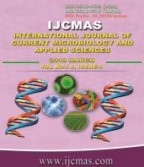


 National Academy of Agricultural Sciences (NAAS)
National Academy of Agricultural Sciences (NAAS)

|
PRINT ISSN : 2319-7692
Online ISSN : 2319-7706 Issues : 12 per year Publisher : Excellent Publishers Email : editorijcmas@gmail.com / submit@ijcmas.com Editor-in-chief: Dr.M.Prakash Index Copernicus ICV 2018: 95.39 NAAS RATING 2020: 5.38 |
Soil potential to stock organic carbon was appraised in hot sub-humid dry agro ecological region (AER 9) of Indo-Gangetic plains with alluvium derived soils i.e. old alluvium with growing period of 150-180 days. The study region is located in South Bihar and it was surveyed for prevailing land uses. There were six land uses viz., rice-wheat-fallow system systems, maize-potato-fallow system, red gram, sugarcane, mango orchard and agro-forestry found prominent in the region. Five representative sites in each land use were selected for sampling in Jehanabad and Gaya district in south Bihar. Soil samples were collected from surface to 60 cm depth with 15 cm increments for soil organic carbon and core samples for bulk density estimation with standard procedures. The result explained that the soil organic carbon stock was observed highest in mango orchards with 9.6 kg m-2 (Range: 7.7 - 11.8 kg m-2) followed by agro-forestry with 7.9 kg m-2 (Range: 6.4 - 9.6 kg m-2), Maize-Potato cropping system with 6.7 kg m-2 (Range: 5.5 - 8.2 kg m-2) Rice-Wheat cropping system with 6.4 kg m-2 (Range:5.6 - 7.6 kg m-2) and red gram mono-crop with 5.8 kg m-2 (Range:4.6 - 6.6 kg m-2). The lowest organic carbon stock of 4.2 kg m-2 (Range: 3.7 - 5.1 kg m-2) was recorded in sugarcane growing soils. Considering mango orchard as reference in the region, sugarcane, red gram, rice-wheat-fallow, maize-potato-fallow and agroforestry has the potential for 54,38,32,29 and 23 t ha-1 of organic carbon to sequester, respectively.
 |
 |
 |
 |
 |